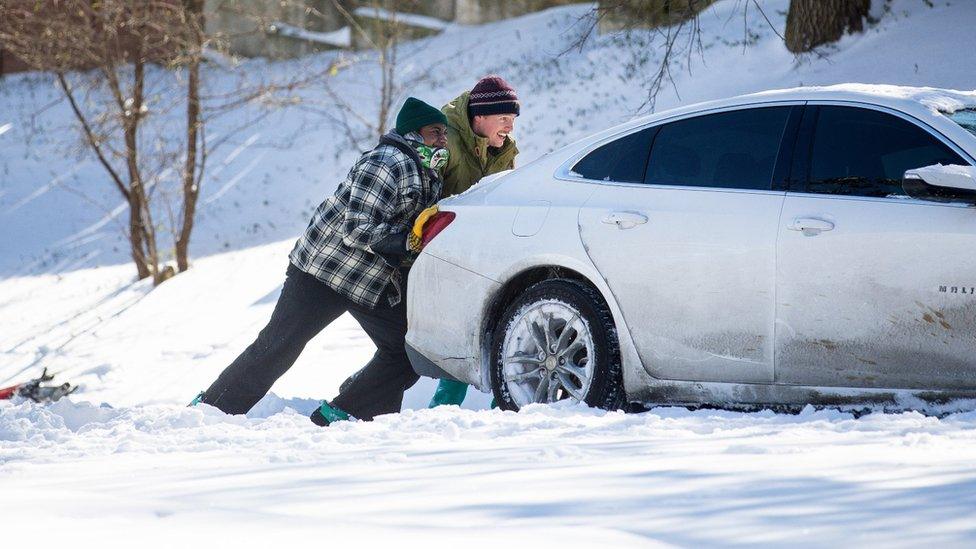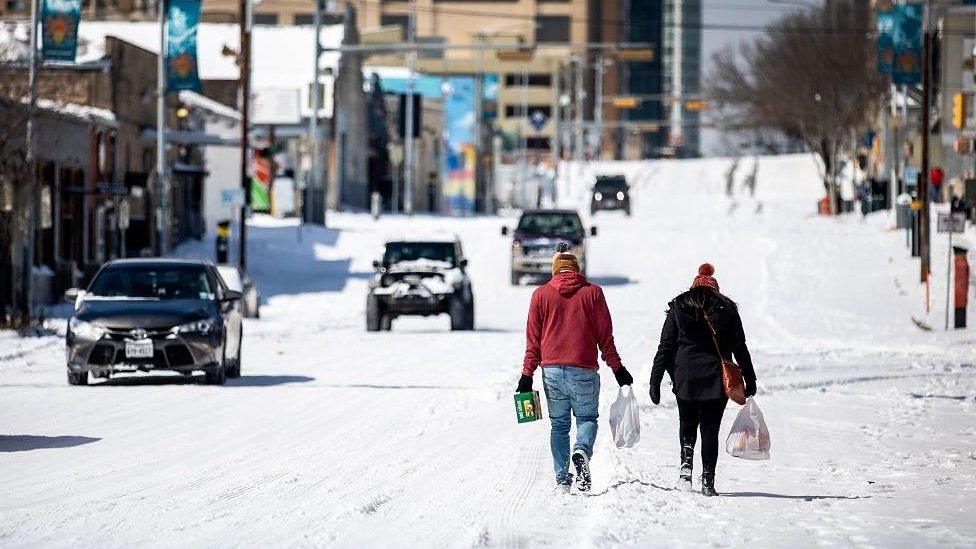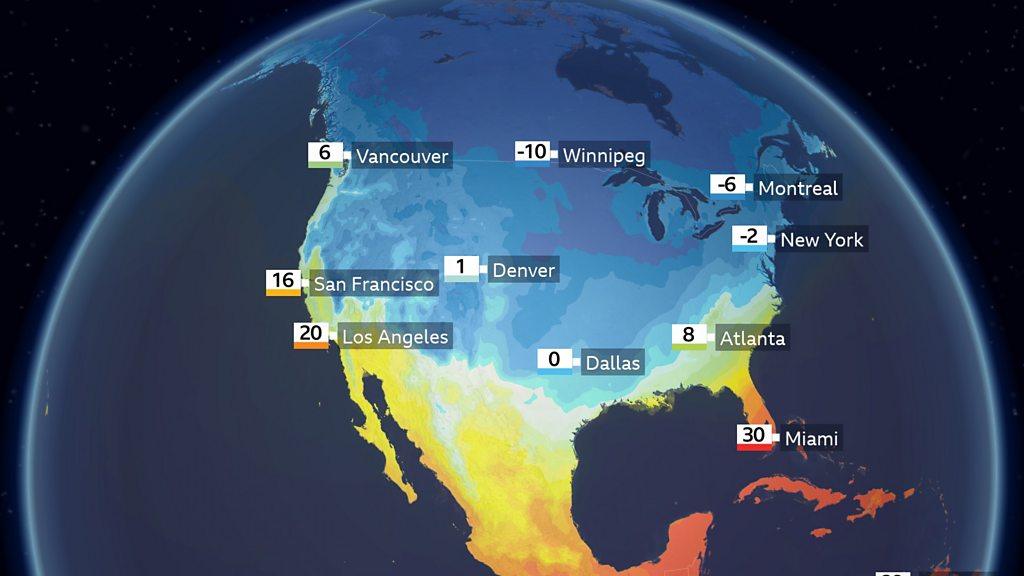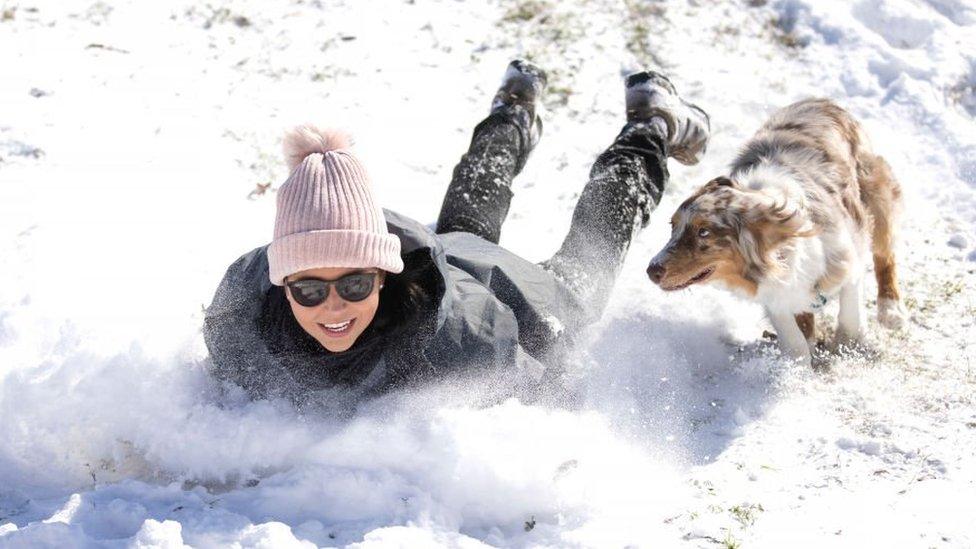Texas weather: How to stay safe in freezing conditions
- Published

A huge winter storm has been sweeping across the southern US
As a blast of winter weather hits Texas and other southern US states, we have rounded up some of the top tips for keeping safe.
It's all about layers
When working out what to wear in freezing temperatures, experts say the answer should always be "layers".
This is because several thin layers of clothing trap heat more effectively than a single bulky item. It also means you have the option of removing excess clothing if you start feeling overheated.
The US Centers for Disease Control and Prevention (CDC) says when venturing outside, people should wear a tightly-woven coat, along with inner layers of light warm clothing, and gloves, a hat, a scarf and waterproof boots.
But it's best to stay indoors and maintain a warm temperature in the house, particularly if you are over the age of 65.
Accessing a water supply
Extreme cold can cause water pipes to freeze and sometimes break. Tips to avoid this include leaving taps slightly open so they drip continuously, and allowing heated air to reach pipes by opening cabinet doors beneath sinks.
However, in some instances this can have an impact on water pressure and levels of supply. In such cases, residents may be asked to switch off the water supply to their homes at certain times in order to maintain access for essential services, such as hospitals.

Residents purchase supplies of bottled water at a store in Abilene, Texas
Winter storms can also cause power cuts, which can prevent water treatment facilities from carrying out essential work and lead to contaminated supplies.
If this happens, a "boil water notice" may be issued, advising people to boil any water before consuming or using in food preparation, such as cleaning fruit or salads.
Even if tap water is filtered, the CDC guidance states that it will still need to be boiled as it may be contaminated.
Only boiled or bottled water - which may be provided by local shelters - should be used, including for brushing teeth.
Food and drink are really important in terms of providing energy and keeping us warm, so make the most of hot chocolates and soups. But you should avoid alcohol and caffeine as they cause your body to lose heat faster, the CDC warns.
Coping with power cuts
If possible, you should stock up on food that needs no cooking or refrigeration in case of power cuts.
The CDC advises having an emergency kit that includes a torch, a weather radio and extra batteries, as well as a first-aid kit.
If you do find yourself stuck indoors during a power-cut, with no option to safely move, there are some steps you can take to keep yourselves as warm as possible.
Winter storm leaves millions of Texas residents without electricity
The National Weather Service in the US suggests placing a rolled up towel at the base of exterior doors, and moving all activities to one room of the house and closing the remaining interior doors to retain heat. Drawing curtains can also help to keep the heat in.
If you think you're getting too cold and your body temperature is dropping then you should get help and in an emergency contact your local emergency services.
Other ways of keeping warm
If you have a gas or wood fireplace, you should use it, or alternatively a portable "indoor-safe" heater.
The CDC notes that turning on the stove for heat is not safe.
You should also keep grills, camp stoves and generators out of the house, basement and garage, as the fumes can be deadly.
If you are seeking warmth in your car, remember the fumes coming out are toxic so always have a window open and never switch on your engine in a closed garage.
Shoes and sand
Being outside is sometimes unavoidable, but there are things you can do to make it as safe as possible.
As a first-step you should accompany your warm clothing with non-slip shoes to try to prevent any falls. The CDC also advises sprinkling cat litter or sand on any icy patches, if it is not possible to avoid them altogether.
It is also a good idea to carry your mobile phone with you, and ensure it is fully charged when you leave the house so that you can contact someone in an emergency. You should also tell someone where you are going and when you are expected to return.
You should not be rushing in freezing weather, so tread carefully and work slowly if doing chores outside.
Preparing for a drive
If you need to drive somewhere, be sure to check the weather and road conditions first. In many instances, early mornings can be the coldest part of the day, and therefore the most dangerous.
Like with walking in freezing conditions, it is also important not to rush.

Health and weather agencies say it is important to clean snow and ice off your vehicle before setting off.
It is also a good idea to have a first aid kit in the car, and you should pack the vehicle with essential winter supplies, like a blanket, hand warmers, drinks and snacks.
Getting stranded
If you do find yourself stranded in your vehicle, the CDC advises tying something brightly coloured to the antenna and turning on the inside overhead lights to make it visible to rescuers.
You should also move everything you need from the trunk to the passenger area, and avoid leaving your vehicle unless you are certain that safety is nearby.
It is important to keep warm so wrap up in extra clothing, blankets or newspapers and huddle together if you are stranded with other people.
You should also stay awake and keep moving. The CDC suggests moving your arms and legs while sitting down to improve circulation and keep warm.
It is a good idea to run the motor, and heater, for about 10 minutes every hour, opening the window slightly to the air in, the agency says. Make sure snow is not blocking the exhaust pipe to reduce the risk of carbon monoxide poisoning.
Related topics
- Published16 February 2021

- Attribution
- Published17 February 2021

- Published16 February 2021

- Published15 February 2021
